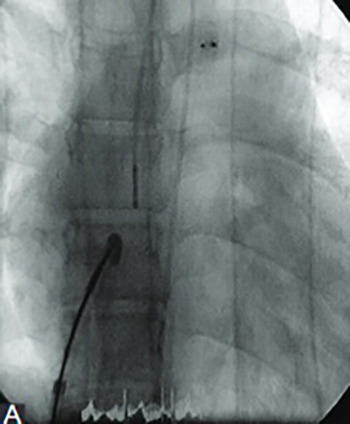NRGTM RF powered transseptal needle: a useful technique for transcatheter atrial septostomy and Fontan fenestration: report of three cases
DOI:
https://doi.org/10.17305/bjbms.2014.4.60Keywords:
transseptal puncture, transseptal needle, pulmonary hypertensionAbstract
Transseptal puncture (TSP) is a frequently performed procedure for gaining access to the left atrium for catheter ablation, hemodynamic assessment of the left heart, left ventricular assist device implantation, percutaneous left atrial appendage closure or mitral valvuloplasty during childhood and adulthood. The standard technique for transseptal puncture applies mechanical pressure on the fossa ovalis with a Brockenbrough needle. However, this method is not feasible when the fossa ovalis is thick and aneurysmatic. In such patients, the radiofrequency ablation energy systems can be offered as a better alternative for TSP. Here, we aimed to demonstrate the outcome of transseptal puncture performed with an NRGTM RF powered transseptal needle in three patients.
Downloads
References
Crystal MA, Mirza MA, and Benson LN. A radiofrequency transseptal needle: initial animal studies. Cathet Cardiovasc Interv. 2010; 76 (5): 769-773
Ross J, Braunwald E, Morrow AG. Transseptal left atrial puncture: New technique for the measurement of left atrial pressures. Am J Cardiol. 1959;3(5):653-655.
http://dx.doi.org/10.1016/0002-9149(59)90347-9
Blomstrom-Lundqvist C, Olsson S, Varnauskas E. Transseptal left heart catheterization: A review of 278 studies. Clin Cardiol. 1986;9(1):21-26.
http://dx.doi.org/10.1002/clc.4960090105
Roelke M, Smith AJ, Palacios IF. The technique and safety of transseptal left heart catheterization: The Massachusetts General Hospital experience with 1,279 procedures. Cathet Cardiovasc Diagn. 1994;32(4):332-339.
http://dx.doi.org/10.1002/ccd.1810320409
De Ponti R, Cappato R, Curnis A, et al. Trans-septal catheterization in the electrophysiology laboratory: Data from a multicenter survey spanning 12 years. J Am Coll Cardiol. 2006;47(5):1037-1042.
http://dx.doi.org/10.1016/j.jacc.2005.10.046
Fromentin S, Sarrazin JF, Champagne J, Nault I, Philippon F, Molin F, et al. Prospective comparison between conventional transseptal puncture and transseptal needle puncture with radiofrequency energy. J Interv Card Electrophysol. 2011; 31(3): 237-242
http://dx.doi.org/10.1007/s10840-011-9564-2
Fraisse A, Bonnet JL. Protein-losing enteropathy: radiofrequency fenestration of the atrial septum after failure of transseptal needle puncture. Pediatr Cardiol. 2004; 25(1): 84-86
http://dx.doi.org/10.1007/s00246-003-0506-3
Sager JS, Ahya VN. Surgical therapies for pulmonary arterial hypertension. Clin Chest Med. 2007; 28(1): 187-202.
http://dx.doi.org/10.1016/j.ccm.2006.11.003
Roelke M, Smith AJ, Palacios IF. The technique and safety of transseptal left heart catheterization: the Massachusetts General Hospital experience with 1,279 procedures. Cathet Cardiovasc Diagn. 1994; 32(4): 332-339.
http://dx.doi.org/10.1002/ccd.1810320409
Justino H, Benson LN, Nykanen D. Transcatheter creation of an atrial septal defect using radiofrequency perforation. Cathet Cardiovasc Interv. 2001; 54(1): 83-87
http://dx.doi.org/10.1002/ccd.1244
Fink C, Peuster M, Bertram H, Hausdorf G. Transcatheter recanalization of the left main pulmonary artery after four years of complete occlusion. Cathet Cardiovasc Interv. 2001; 53(1): 81-84
http://dx.doi.org/10.1002/ccd.1135
Smelley MP, Shah DP, Weisberg I, Kim SS, Lin AC, Beshai JF, et al. Initial experience using a radiofrequency powered transseptal needle. J Cardiovasc Electrophysiol. 2010; 21(4): 423-427
http://dx.doi.org/10.1111/j.1540-8167.2009.01656.x
Nihill MR, O'Laughlin MP, Mullins CE. Effects of atrial septostomy in patients with terminal cor pulmonale due to pulmonary vascular disease. Cathet Cardiovasc Diagn. 1991; 24(3): 166 -172.
http://dx.doi.org/10.1002/ccd.1810240305
Althoff TF, Knebel F, Panda A, McArdle J, Gliech V, Franke I, et al. Long-term follow-up of a fenestrated Amplatzer atrial septal occluder in pulmonary arterial hypertension. Chest. 2008; 133(1): 283-285.
http://dx.doi.org/10.1378/chest.07-1222
Galie N, Hoeper MM, Humbert M, Torbicki A, Vachiery JL, Barbera JA, et al. Guidelines for the diagnosis and treatment of pulmonary hypertension. Task Force for Diagnosis and Treatment of Pulmonary Hypertension of European Society of Cardiology (ESC); European Respiratory Society (ERS); International Society of Heart and Lung Transplantation (ISHLT). Eur Respir J. 2009; 34(6): 1219-1263.
Keogh AM, Mayer E, Benza RL, Corris P, Dartevella PG, Frost AE, et al. Interventional and surgical modalities of treatment in pulmonary hypertension. J Am Coll Cardiol. 2009;54(1 Suppl): S67-77.
http://dx.doi.org/10.1016/j.jacc.2009.04.016
Özdemir N. Atrial septostomy in pulmonary hypertension. Anadolu Kardiol Derg. 2010;10(Suppl 2):27-30
http://dx.doi.org/10.5152/akd.2010.127
Asgar AW, Miro J, Ibrahim R. Recanalization of systemic venous baffles by radiofrequency perforation and stent implantation. Cathet Cardiovasc Interv. 2007; 70: 591-594

Downloads
Additional Files
Published
License
Copyright (c) 2015 Bosnian Journal of Basic Medical Sciences

This work is licensed under a Creative Commons Attribution 4.0 International License.













